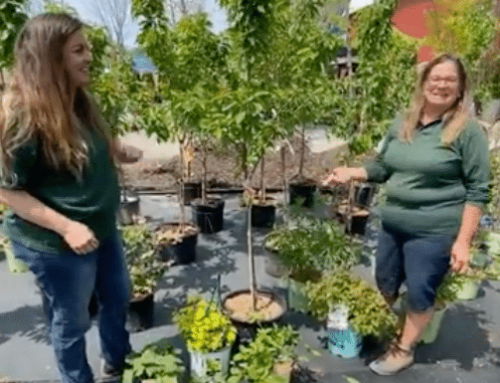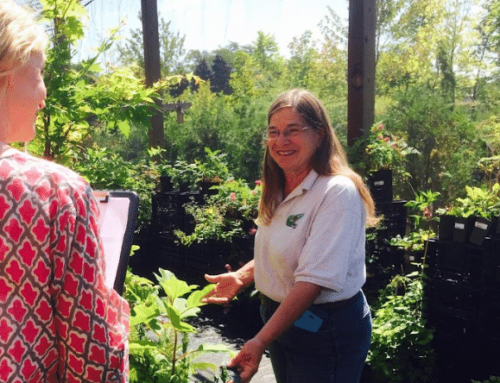Jessica 0:05
Welcome, we’re here at Broccolo Garden Center. I’m Jessica DeMasio. I’m the general manager and I am here with Laurie Broccolo. And we are going to talk a little bit about happying your gardens, and maybe some of the better tools that we can use to do that. And I see Laurie, you’re holding a few things there. So what do you got?
Okay, so since I’ve been farming, it’s, I’ve always been looking for easier ways. And this is an area that’s already had gardens in the past. So we have tilled it, we have added compost and that we plan for every single year, we just we did this because we’ve come up over the winter through now. The next thing I’m going to be doing though, is I want to make sure that we can dig in and turn it over and notice it’s not going that far. So really have to do this every single year, completely. You know, dig in, just to get a good six to eight inches. 16 inches is what you really need for the roots.
Six to eight inches is definitely what you need for any of your plants. So if you’re doing a race bats are usually about 18 inches, but it’s the first six to eight inches where the roots are really, really important. And then we still add amendments. So even though I’ve loosened the soil, I always always want to add compost, by the way bumper crop is the absolute best.
Laurie 1:46
This is the greatest soil builder there is they have another one similar, it’s called potting soil bumper crop gardeners goal, which is great because it’s a little more drainage in it for pots. But for your gardens, every tree shrub, radial and annual in the soil to be mixed. And it’s not a lot. I took one school, just a shovel and now show you how to plant properly. We also want to show you sometimes just to get them the weeds out. This is the type of thing that we do initially, just to get the roots loosen to get rid of those nasty, competing weeds, which is what I hate about a vegetable garden because I feel like I’m compelled to constantly have to get out here we’re going to talk about techniques there as well. And my absolute favorite place to call home matter homematic. It’s a Maddix and kind of hole. You can see people with a big huge pick type axes. Yep, this is the
Jessica 2:52
Same never you’ll never be a gardener without that tool.
Laurie 2:56
Leverage. Yes. All right. And that’s why I use the short handle shovel to I’m looking for more leverage for my body strength. Some of the guys, they can go with long handled shovels, it just isn’t gonna work for me. So I want to make sure that I’ve got a little bit of mixed in here and that we don’t plant too deep. I’m going to show you how I know that that is too deep. Because look, level, this root STEM is down below.
Jessica 3:31
Something that is a common mistake is planting way too deep.
Laurie 3:37
I want it right at the soil level. And I want to be seeing the actual root flare at the top of the crown of the roots. Okay, and that’s that.
Jessica 3:49
The same is for anything that you’re planting, right, Laurie? Yeah, it’s a tree a shrub. You want to see that root flare, be completely level with the ground that you’re putting it in.
Laurie 4:01
And looking at our spot right here you can see I have shade I’m in the shade right now, but in about an hour, and it’s going to be what a little after noon noon. Yeah, this is gonna be hot, sunny afternoon sun. So I have something for plants to crawl on. And that means I can put a cucumber over here. I can put different kinds of beans and train it to go up through the trellis. And that’s what we do every year. Then we planted a few perennials that come back every year. We’ve already harvested some but check out this asparagus because it’s not going to be here very long. It’s going home with me and that asparagus isn’t just you know, delicious tea it will I think it adds some really really pretty interest to your garden and and if you actually let it stay in bloom it is a gorgeous flower. But I’ll usually eat it ahead of time.
And so this plant actually takes several years for the roots to develop and start to get enough to power. So that thinking about how you’re going to place your plants, that when I just took care of, obviously, my harbor is going to be a fairly tall and cherry tomato plant. So that means it’s going to need support later in the season. This one heirloom tomatoes, it’s also going to be fairly tall, you know, like, you know, 1520, sometimes they can get even bigger, depending if your soils really good. And as soon as they get those heavy tomatoes, they start to fall over, and then the slugs get them. So you’ve got to stand them up off the ground,
you always want to definitely give your tomatoes support. And you it’s really best once they start to grow, to prune off those lower leaves. So they’re not nothing’s touching the ground, you don’t want any of your leaves touching the ground. And so that’s another reason why it’s important to make sure that you have some sort of support system, whether it be the tomato cages or you know, a trellis with strings on it. And I’ve seen a lot of people do like budget ways of, of keeping their tomatoes. And so yeah, there’s lots of different methods. So I
look at layering and just like you would any other garden where the taller things are in the back, really tall baby things in the far back. And then as you get closer to the front part of the garden, you can use things like crawling to use like cucumbers, and let them crawl and it actually helps. Again, you’re gonna have to prop up the actual cucumber, but the plant itself gets so thick that it helps to keep the weeds out. So think about it NAFTA. And also, most of the almost all of the herbs are perennial, and they can come back every year. So this is Sage, and the herbs like it hotter. So they can go out on the edge and really handle the heat where the other plants really need to have a lot more moisture. So that will help the plant the herbs and that stop the other plants from having the soil dry up too much. Or it’s kind of a protected almost like a buffer of low growing drought types of plants perennials. Plus, if you let them go to flower, they help bring in the pollinators. So this is our little kitchen garden. Here’s some chives that came up again from the last year garlic chives, the spirit guess. Sonos will self sow, love this plant. And that will sell so a lot of times over in here. So we’ll try to keep the things that are going to spread into one section. And then we’re replanting new stuff in another area. So just kind of planning it out every single year.
Jessica 8:08
How much space do you think that there should be between two tomatoes? Right? Because I know that this is going to get quite large.
Laurie 8:13
Right. So we’re going to need a couple feet. Okay, definitely a good couple of feet between anything that’s shrubby. And then as far as paths go, who’s going to get to my vegetables before? I do? It’s really frustrating. Sometimes, the wood shops I have no comment. No one checks. But I can tell you like the deer. And even some of the bunnies. They do not like the black netting. So if it’s a real serious problem, you can put black netting over the plants. And it will really discourage them from getting in there and the plants can grow up through it. What else can we do? There’s always you know, the spray is like liquid fans.
Jessica 8:56
Can I ask a question? When I was a kid growing up, we had a vegetable garden and it was amazing. My dad always had a border of miracles around the entire vegetable garden and he said it was for a reason. Now what reason would that be?
Laurie 9:12
It is the smell and it does help keep things like the deer away. Okay. And also when I was talking about herbs, they have a strong smell too. So thinking about that as a border, and yes, add in some marigolds and Cistercians and Zinnias because all of those petals can actually be sprinkled in. So the lot of flowers that we can eat and then create a lot more fun texture and interest. And we don’t typically I don’t suggest spraying anything. We’re not into spraying for pests. If I see something, I’m gonna grab that caterpillar and just take them off and stomp on finding ways to keep the deer away otherwise you can do fencing, if you lived in Iran adequate, you’re gonna need an eight foot fence all the way around. There’s no doubt about it. But then you need to see
Jessica 10:08
What about you know if you’re if you’re dealing with other pests, like aphids, but you also see that you’ve got some ladybugs hanging around. That’s a sign that you definitely do not need to spray anything. Right?
Laurie 10:23
Right. And also the aphids are not eating your actual, the fruit, okay, they’re, they don’t eat the herbs. They like soft tissue, and you’re not eating. So what if a few bugs eat some leaves? As long as they’re not ruining your harvest?
Jessica 10:43
That’s a good point. So do they even really need to be gone? Right? Yeah, in many cases, they’re not harvesting, damaging what you are getting out of it exactly. Okay, that makes sense.
Laurie 10:56
So hopefully this gives you some good tips in that you’re not afraid to try some small spots.
Enhance the vitality of your garden with our expert planting techniques and soil amendments at Broccolo Tree and Lawn. We understand that successful gardening starts with the right foundation, and our skilled team of professionals is here to guide you every step of the way.
Our expert planting techniques ensure that each plant is positioned and cared for in a manner that promotes healthy growth and optimal aesthetics. We take into consideration factors such as sunlight exposure, soil conditions, and spacing to create a harmonious and balanced garden layout.
In addition to precise planting, we offer strategic soil amendments to improve soil quality and fertility. Our team analyzes the composition of your soil and recommends amendments tailored to the specific needs of your plants. From organic matter incorporation to pH balancing and nutrient enrichment, we utilize proven techniques to create an optimal growing environment.
With our comprehensive approach to planting techniques and soil amendments, you can expect your garden to thrive, showcasing vibrant blooms and robust foliage. Whether you’re starting a new garden or rejuvenating an existing one, our expertise will help you achieve the garden of your dreams.
Discover the transformative power of our planting techniques and soil amendments. Explore our services and unlock the secrets to a flourishing and abundant garden. Contact us today to schedule a consultation and embark on your journey towards a thriving outdoor oasis.






